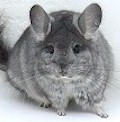In case you didn't know, chinchillas are not from around here. They were brought up here because someone thought they would make good pets, and they were right! There are some things about a chinchilla's natural habitat that will explain why they do some of the things they do.
Chinchillas are actually native to the Andes Mountains in South America. Their natural habitat is cold, dry, and rocky. They live on the mountainside in burrows and rock crevices. They get around on the rocky surface by jumping and climbing over the terrain. They can jump extremely high for their size, up to six feet in the air!
These little creatures are among the softest in the world because of their super-thick coat. Their fur is so dense that common pests like fleas will suffocate if they try to live on a chinchilla. This fur coat keeps them nice and warm in their native habitat, but can pose a bit of a problem for anyone that wants to have a chinchilla as a pet. Chins don't sweat so the only way for them to cool down is by pumping blood into their thin ears to cool. So if your chinchilla's ears get red, he's probably over heating!
Because of their thick coat and need to stay dry, chinchilla's clean themselves in quite an odd sort of way. Instead of dipping in a pond, they will actually roll around in volcanic rock dust or ash that is fine enough to penetrate their dense fur. This dust will absorb oils, dirt, and moisture to keep the chinchillas clean, dry and healthy. If a chinchilla stays wet for long enough, they will likely develop ringworm or another fungus on their skin.
The sort of predators that would go after these small furry creatures include birds of prey, various canines, some felines, even skunks and snakes. To get away from their hunters, chinchillas have several defensive mechanisms like releasing fur if they get bit, and spraying urine. They are also social creatures that live in herds so they can watch out for each other and give warnings of potential danger.
In their wild habitat, chinchillas eat all sorts of stuff like fruits, seeds, plants, and even small insects. However, most domestic chinchillas have a much more sensitive digestive system, and could not live on that sort of diet. Your pet chinchilla should be kept on a strict diet of pellets and hay , with the occasional treat.
